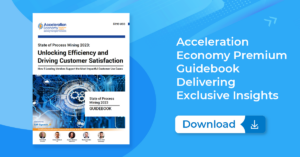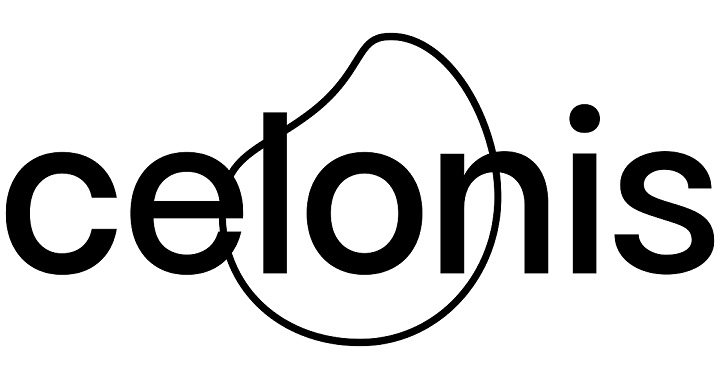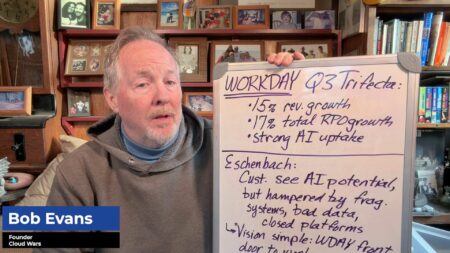
Celonis is building on recent product developments — including technology that provides end-to-end process visibility and its API that fuels connections to third-party systems — with standardized data that customers can use to trigger process optimizations within its own platform and those of ecosystem partners.
The process mining leader says its new Process Intelligence Graph leverages artificial intelligence (AI) along with standardized process knowledge and data to provide a shared, system-agnostic language for taking actions that deliver rapid value to a business.
Process Intelligence Graph headlines the company’s product announcements taking place today at Celosphere, its annual customer conference in Munich.
Discover how AI has created a new ecosystem of partnerships with a fresh spirit of customer-centric cocreation and a renewed focus on reimagining what is possible. The Acceleration Economy AI Ecosystem Course is available on demand.
The Process Intelligence Graph consolidates data and knowledge that has been gathered from thousands of customer deployments since the company’s inception more than a decade ago; it includes KPI definitions and key opportunities that customers can pursue. The company refers to the Process Intelligence Graph as a digital twin of customers’ processes. It makes automation, such as software bots, more intelligent, since they become informed by Celonis’ end-to-end process visibility, rather than targeting individual processes and tasks in isolation, as bots might otherwise do.
The Process Intelligence Graph builds upon Celonis’ Object Centric Process Mining technology that, for the first time, provided an end-to-end view across processes rather than monitoring and optimizing individual processes in isolation. It also leverages the Intelligence API that makes it possible to “pipe” data and insights into other systems; for example, triggering workflows in ServiceNow or representing insights in Microsoft PowerBI.
The company is ramping up its emphasis on connections to other applications in customers’ software ecosystems as it positions Celonis software as a layer that sits between those enterprise systems (such as SAP, Oracle, and ServiceNow) as well as automation and AI applications.

“The unification of all the process data in the enterprise starts to become the ideal data foundation when it’s contextualized with how processes run and why they run that way to be a necessary input for AI deployments and for better automation of end-to-end processes,” says Divya Krishnan, vice president, product marketing at Celonis.
Explaining the types of insights made possible by the Process Intelligence Graph, Krishnan said, “The process knowledge is ‘why do the processes operate the way that they do and where is the hidden value potential? Both of these are now being augmented by our ecosystem.” This implies greater collaboration and data sharing than ever before with those software companies represented as the “enterprise core” and those in the “smart business layer” as represented in the “tech stack” schematic below:

Krishnan describes the Process Intelligence Graph as a “unified data model and a productized knowledge layer” that sits on top of the Celonis platform; customers can run it in parallel to their existing implementation if they choose that approach.
To understand how the Process Intelligence Graph aligns with the existing Celonis process mining platform, the visual representation below is helpful; the components within the dotted line make up the expanded Celonis platform, but the schematic makes clear the role of current and future tie-ins to the ecosystem and third-party applications. “Being able to enable action automation in external platforms is a big, big focus for us,” Krishnan says.

Here’s an example of how the Process Intelligence Graph can work in practice: Celonis process knowledge can provide visibility into safety stock (inventory) levels and their impact on working capital. That data can be combined with sales order data and purchase order data from multiple systems of record such as Oracle or SAP. Using that data, AI is utilized to predict late payments, extended lead times, or duplicate invoices.
Also introduced at Celosphere: Generative AI-driven Process Copilots that provide a chat interface to the Process Intelligence Graph and accelerate the process of identifying value opportunities.
“What customers have been really excited about is the idea that in addition to all the data that they already have, they can bring process intelligence to the table as another input into their AI deployment,” Krishnan says. The end result: the opportunity to realize value faster from the Process Intelligence Graph.
Chris Monkman, Celonis’ vice president, product management, describes the Process Intelligence Graph as a “causal graph” that identifies common problems within a process and how they can be fixed thanks to “recommended opportunities” from the Process Copilot. “Our hope is with our copilot and all this experience that we have, we can provide much more useful opportunities for improvement, for example, across all these difference source systems” such as SAP, Oracle, Workday, and others.

With the addition of the Process Intelligence Graph, the Celonis platform moves closer to unlocking a “network effect” whereby process intelligence and optimizations can be shared across companies. That can drive significantly greater value beyond process mining use cases deployed solely within an organization. “When many of our customers have this graph in place, they can share intelligence across their value chain,” Krishnan says.
We expect to learn more about customers collaborating to realize that network effect with Celonis software at Celosphere.
Emphasizing the role of partners in developing and expanding the Process Intelligence Graph, Krishnan says: “We do have partners who are already working with us in pilots to extend the graph,” and she cited the example of supply chain objects and events from a logistics provider. Those partners “are starting to provide additional out-of-the-box data, definitions of objects and events at the data model level and supplementing at the knowledge level with additional industry benchmarks, KPI definitions, and improvement opportunities that they’re finding.”
In addition to the Process Intelligence Graph and Process Copilots, Celosphere product announcements also include:
- Enhancements to the Studio development tool: Make it easier for customers and partners to co-create functionality within the Celonis platform using this tool for building applications and components. Customers in the past have co-created Celonis apps (Lufthansa, for example, and ERGO Group as well) so these enhancements could accelerate such initiatives.
- Transformation Hub: This built-in dashboard functionality lets customers track performance, results, and value realized within the platform itself, rather than using offline methods such as spreadsheets or third-party visualization tools.
- Material Emissions App: Uses process intelligence to simplify Scope 3 emissions reporting for procurement organizations. Scope 3 emissions are indirect emissions from sources including business travel, commuting, and third-party deliveries. The software provides a single location for automated measurement and recommended actions related to Scope 3 emissions sources.
In another significant product development, the company announced the day before Celosphere it has acquired Symbioworld, with plans to integrate the company’s business process management software with the Celonis platform.
Closing Thoughts
With these new developments, Celonis is:
- Raising the value and reach of process mining by delivering functional upgrades that can be leveraged in its own and major third-party software platforms
- Creating new opportunities for cross-company process collaboration
- Capitalizing on AI to make recommendations, and enable actions simply, for optimized processes
- Placing greater emphasis than ever before on the ecosystem of partners that can use process intelligence in their applications and services
- Continuing to build on the expanding range of functions and business objectives that customers can address with process mining and process intelligence
It’s an ambitious agenda that sets the stage for customers to deliver broader and deeper impact from process intelligence in 2024.










